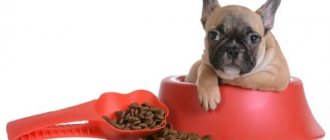At two months, the kitten is weaned from its mother, and less often, it is weaned from breastfeeding. But in any case, it is transferred to the “adult” menu.
This is no longer feeding, like for one-month-old babies, but a complete diet. The more balanced and nutritious it is, the healthier the puppy will grow up.
During this period, it is important to properly plan your diet. If the dog is the first, it is easy to make mistakes that will affect the body. We will consider in detail the issue of feeding two-month-old puppies, as well as the nutritional features of large, medium-sized and decorative breeds.
Important rules and organization of the feeding area
Anyone who has a dog for the first time has many questions about how to feed a puppy. They are easy to understand if you pay a little attention to the important rules.
Main feeding rules:
- It is important not to overfeed your puppy to prevent his stomach from becoming bloated. Large breed dogs are at risk of developing joint problems due to overeating, and other breeds may be prone to obesity.
- Never give animals food from your table. This food is not suitable for the digestive system of dogs and cats.
- If you feed your baby natural food, then the food should always be fresh.
- It is recommended to feed the animal at the same time.
- Food should be at room temperature.
- Give your puppy 10-15 minutes at each feeding. If during this time he has not finished his portion, then it must be put in the refrigerator so that it does not spoil.
- A bowl of fresh water should always be there.
- Dry food should not be mixed with natural food.
- Do not give your puppy chocolate, flour, processed foods, spices and other foods that are considered treats in the human world. They are very harmful to the dog.
- Dairy and meat products should not be given at the same feeding.
- Never give your puppy bones - you need to teach your baby to chew and not swallow them whole. In addition, not all bones are suitable - for example, tubular ones are strictly prohibited.
Puppies' meals should be organized in a specially designated place where it is convenient to maintain cleanliness. The most comfortable place is the kitchen. It is better to place the bowls on a rubber mat so that they do not slip.
While the puppy is small, the bowl can be placed directly on the floor. When he grows up, it is better to use a stand to make it more convenient for the animal to eat and not strain the cervical spine. This will also help prevent you from swallowing air while eating.
The bowl should be ceramic or iron, not plastic. It will be more stable and the puppy will not tip it over.
There should be different plates for water and food - it is advisable that they stand at a distance from each other - so that pieces of food will not fall into the water and spoil it.
Prohibited Products
Newly-made owners are often afraid to make a mistake and feed their furry baby food that is harmful to him. In addition to the fact that you should not give puppies cold and hot food, there is an important list of foods prohibited for them:
- bread, loaf, sweet pastries;
- candies, chocolate, honey, jam;
- everything that causes flatulence and bloating - cabbage, grapes, peas, beans, plums;
- pork;
- River fish;
- fried, spicy, salted, smoked;
- sausages;
- ketchup, mayonnaise, various sauces;
- bones.
?
Food from a human table is unacceptable and dangerous for puppies.
Features of feeding puppies by breed
The nutrition of puppies of different breeds varies. This has to do with the size of the dog, its activity needs and background history.
Large
The diet for breeds such as Alabai, Doberman, Rottweiler, St. Bernard, Great Dane, Newfoundland, East European Shepherd and others requires a special approach. This is due to the fact that large dogs grow quickly and gain weight, and this places a heavy load on the musculoskeletal system. When choosing a diet, you must take this into account and under no circumstances overfeed large breed puppies.
The diet of large dogs should be enriched with protein and calcium. For normal growth and development, raw meat and fish should predominate in the daily diet by 50-60%. Particular attention should be paid to additional vitamins and microelements: glycerophosphate, phytin, calcium gluconate.
The diet of a 2-month-old large breed puppy should consist of:
- 60% from animal proteins (meat, fish, offal, dairy);
- 20-30% - from carbohydrates (cereals, fruits);
- 10-15% - from fiber (vegetables) and other foods.
Dogs of Japanese origin (Akita Inu, Shiba Inu, American Akita) need fish in larger quantities. Historically, meat is less healthy for them than seafood.
Average
Jack Russell Terrier, Labrador, Dachshund, Beagle, Cocker Spaniel, Staffordshire Terrier, German Pinscher, Medium Spitz, Corgi are all medium or small breed dogs. Their distinctive feature is activity, so they spend a lot of energy. Their diet includes 50-60% meat and dairy products, and the rest of the menu consists of vegetables, fruits, and cereals.
Puppies are given food little by little, but often (about 6 times a day). A sample menu should include cottage cheese, sour cream, milk porridge, meat, vegetables, fruits and non-acidic berries.
Small
Puppies of small and dwarf breeds have an accelerated metabolism. They spend a lot of energy maintaining body temperature. In addition, they are very mobile, so they quickly burn up calories.
Puppies of decorative breeds need high-calorie food rich in proteins (at least 75%) and carbohydrates. Feeding puppies should be frequent, and the portions should be small (due to their small stomachs), but satisfying.
You also need to take into account that small breed dogs have small teeth, so food should be cut into small pieces, and dry food should be soaked in water. Pates and pouches are perfect for feeding these puppies.
Small dogs have a lot of stress on their spine. To avoid problems, the pet must receive sufficient amounts of calcium and fluoride, which are contained in dairy products.
What and how to feed a puppy correctly
The rules for feeding puppies depend, first of all, on their age. At each period of life, they have certain developmental characteristics and nutritional needs.
What to feed a puppy at 1 month
The situation when a dog breeder ends up with a month-old puppy in his arms is quite rare. Puppies are usually weaned from their mother at the age of two to three months, when they are able to socialize normally without danger to their physical and mental health. But unforeseen circumstances happen when you have to feed a small baby, for example, loss or shortage of milk, illness of the mother dog or her death. The digestive system of small puppies is not sufficiently developed, many nutrients are not fully absorbed or not absorbed at all, so food for a month-old kitten must be selected with extreme caution.
The best option is a substitute for bitch's milk. These are special dry mixtures for puppies, containing the entire necessary set of nutrients and microelements. They contain a natural concentrate of colostrum - a source of immunoglobulins that contribute to the formation of good immunity. Neither cow's nor goat's milk can replace dog's milk and provide the puppy's body with everything it needs.
In parallel with feeding with formula milk, complementary foods should be carefully introduced. At first it is liquid porridge, then boiled, ground tender meat. Feeding a one-month-old puppy what older animals are fed is strictly prohibited.
What to feed a puppy at 2 months
When organizing proper nutrition for a small puppy, it is important to immediately decide which type (natural or dry) you choose, so as not to change it later.
If you have chosen to feed natural products, then it is important to know exactly which foods are allowed for two-month-old puppies and which are not. The diet of small pets, starting from the age of two months, must include: meat, dairy products, eggs, vegetables, cereals; soups with meat or vegetable broth are recommended.
The daily diet should consist of almost 50% dairy products, since the body of a two-month-old puppy is in dire need of calcium, which is necessary for the normal development of the skeletal system, teeth, and the prevention of rickets. The most optimal treats are kefir, fermented baked milk, yogurt, cottage cheese, sour cream. You need to buy either low-fat products or products with a low fat content. The use of products with flavors and dyes is prohibited.
Meat and fish should make up approximately 30-40% of the daily diet. The most suitable types of meat are beef or poultry. They should be given boiled. It is recommended to exclude pork due to its fat content. It is better not to grind the meat into minced meat, as it sticks together into lumps that are not completely digested in the stomach. It's better to chop it into small pieces.
Vegetables and cereals should make up 10-20% of a two-month-old puppy's diet. Rice and buckwheat are suitable cereals. Porridge should be well boiled in milk or vegetable broth. It is advisable to give different foods at different meals, and not mix everything together. What can you feed a two-month-old puppy using the example of one day:
- In the morning, you can offer a dairy menu: it is quite easily digestible and does not overload the gastrointestinal tract.
- In the afternoon, cook something meaty: boiled poultry or beef plus a couple of spoons of porridge.
- For evening feeding, as for morning feeding, it is better to prepare something light, for example, low-fat or low-fat cottage cheese.
Vegetable oils should not be included in the menu of a two-month-old puppy. It is also not recommended to add salt to food or spices.
A two-month-old puppy needs to be fed every three hours, that is, about six times a day. Portions should be small, appropriate for age standards.
Introduce fish into your baby's diet. If he refuses to eat it in its pure form, try mixing the fish mass into the porridge. The fact is that fish at this age is very important, as it contains a large amount of phosphorus, which is necessary for the normal development of the skeletal system and teeth. But fish can only be given boiled and without bones.
What to feed a puppy at 3 months
The older the puppy gets, the less dairy products should be on his menu. Instead, the amount of meat ingredients should be increased. But three-month-old puppies still need dairy products, the main supplier of calcium. The daily diet of a three-month-old puppy should consist of 30-40% dairy components and approximately 50% meat components. Cereals and vegetables, respectively, should occupy 10-20% of the total daily menu.
You can give the same foods as a two-month-old puppy. But the portions increase, and the frequency of feedings decreases by 1-2 times.
What to feed a puppy at 4-5 months
At the age of four months, puppies begin to demonstrate their taste preferences. Try to take this into account. If your pet prefers dairy products, offer more cottage cheese or kefir. If your baby enjoys eating meat, then include more animal proteins in the menu. But don’t exclude milk completely – try to mix it with porridge.
It is not recommended to mix different types of protein in one feeding. Space out your intake of meat and dairy products. A cocktail of meat, fish and cottage cheese will not bring anything good to a growing organism with a fragile digestive system, but will only do harm. The number of feedings the puppy receives during the day is enough to give him everything he needs (there are about 4 of them).
Up to 6 months, porridge for puppies is prepared mainly with milk. But, if the porridge contains meat, then it should be cooked in meat or vegetable broth.
If your baby refuses fruit, you can add fruit purees to porridge. Puppies have an enviable appetite, so this supplement is unlikely to stop them from eating, for example, their favorite buckwheat or chopped meat.
What to feed puppies at 6 months and later
Starting from the age of six months, the puppy is gradually transferred to the diet of adult animals with three daily feedings. The meat component of the daily menu is determined at the rate of 20-25 g of meat per 1 kg of pet weight. Beef, rabbit, poultry, and fish fillets are used. Fatty meats and fish are not recommended at any age. Various offal products are useful, especially liver.
Do not give your puppy bones, especially tubular ones. Like ordinary sticks that small pets love to chew, their fragments can cause injury or intestinal obstruction. You can replace natural bones with a special treat from a pet store - collagen or vein bones.
The remaining cereals are buckwheat and rice; you can add oatmeal if tolerated well. Porridges are prepared with meat or bone broth. Bone broths are more flavorful and taste better. You can cook bone broth, then remove the bones, add grains and meat. There is no need to specially salt food for dogs; there is enough natural salt in the food. Boiled cereals can be prepared for future use and stored in portions in the freezer.
Vegetables are required in the diet, with the exception of potatoes and legumes, eggs (1-2 per week), vegetable oil (in small quantities).
Don't forget fruits and greens, as well as veterinarian-recommended vitamin supplements.
Keep the feeding area and bowl clean. It is necessary to wash the bowl after every meal.
Basic prohibitions
There are foods that are undesirable or strictly prohibited to be given to two-month-old puppies. Of course, the first thing that is dangerous is constant feeding of junk food. But even an accidentally eaten piece can cause serious consequences.
It would seem that a tiny piece of chocolate or sausage once a month will not affect the puppy’s health. But it's not that simple. The product may not harm, for example, a large husky. But for small Shih Tzus or Chihuahuas, a dose of dangerous ingredients in a piece will be fatal.
Strictly prohibited and “controversial” products
Absolutely harmful to all puppies:
- salty, spicy, smoked, fried, fatty foods;
- semi-finished products and fast foods;
- sausages, canned food, marinades;
- garlic, onion;
- citrus fruit;
- sweets (especially chocolate), confectionery and bakery products;
- grapes, raisins;
- tubular bones of poultry, fish, leather;
- mushrooms, nuts;
- alcoholic, carbonated, sweet drinks.
Some of these products lead to health problems if consumed regularly. Others immediately cause intoxication, allergies, and gastrointestinal disorders.
There are products that some owners consider undesirable, while others consider them harmless if consumed rarely. This:
- pork - raw meat is fatty, may contain helminths, but boiled meat can be fed occasionally;
- potatoes are pure starch when boiled, but you can treat them with 1-2 slices of raw root vegetables;
- tomatoes - a large amount can lead to poisoning, but in small doses they remove plaque from teeth;
- honey is an allergen, but at the same time a storehouse of useful substances;
- semolina and pearl barley are pure carbohydrates and cause bloating, but porridge with milk helps exhausted babies at 2 months to gain weight;
- peas, soybeans, beans, beans, corn: they cause gas formation and are difficult to digest, but if the dog loves them, a few grains will not harm.
How often to feed a puppy
The frequency of feedings depends on the age of the baby. When transitioning to solid food, puppies are fed 6 times a day, and by 10 months they switch to feeding twice a day.
| Age | Feeding frequency | Feeding time | Kcal per day | G/kg weight (per day) |
| From 0 to 2 months. | 5-6 times | 7-00 10-00 13-00 16-00 19-00 22-00 | 200-250 | 25-30 |
| From 2 to 4 months. | 4-5 times | 7-00 10-00 14-00 18-00 22-00 | 250-270 | 30-35 |
| From 4 to 6 months. | 3-4 times | 7-00 12-00 17-00 22-00 | 130-150 | 25-30 |
| From 6 to 10 months. | 3 times | 7-00 13-00 – 14-00 21-00 – 22-00 | 120-130 | 20-25 |
| From 10 to 12 months. | 2 times | 7-00 21-00 – 22-00 | 100-110 | 20-25 |
The table shows the calculation of premium dry food. Cheaper foods are lower in calories, so you will need more of them.
Natural food is calculated according to the dog’s weight. Before six months, a puppy needs 6% of its body weight, after six months – 4% of its body weight.
Feeding puppies dry food
When getting a dog, every owner faces the dilemma of what food to feed the puppy: dry or natural. Feeding your pet natural food is cheaper, but preparation takes a lot of time. Therefore, many owners eventually switch to dry food.
Product selection
If you have chosen to feed dry food, then you must take into account that not all varieties are suitable for feeding puppies. It should be high-quality holistic or super-premium food. On the packaging, manufacturers indicate for which breeds and ages a specific product is recommended, the daily amount, the volume of a single serving and the feeding regimen (number of meals). Please read the instructions carefully to avoid mistakes.
Do not increase the recommended amount of food for a single feeding, even if your pet shows an increased appetite. All manufacturers' recommendations are compiled by specialists - zoo nutritionists and veterinarians. The restriction especially applies to breeds prone to obesity (cocker spaniels, pugs, basset dogs, dachshunds, Rottweilers, Scottish shepherds, Labradors).
Never mix natural foods and dry food, as they are digested differently. By receiving a cocktail of natural products and dry food, a small pet can be exposed to a number of serious diseases of the gastrointestinal tract, urinary system and metabolic disorders.
Having chosen feeding prepared industrial products as the main type of nutrition, do not introduce additional vitamin supplements into the diet. This can lead to hypervitaminosis.
How to transition a puppy to drying
The transition to “drying” should not begin until the pet is 2 months old if it was fed natural food in the nursery. Dry food should be introduced gradually. The granules are pre-soaked and only then offered to the pet.
Veterinarians recommend choosing premium or holistic foods that are created taking into account the needs of young pets and do not contain harmful impurities.
Careful study of the manufacturer's recommendations allows you to choose a dosage. Information is located on the packaging and explains how to calculate the portion taking into account the weight and age of the puppy. Remember - an independent increase in the amount of food leads to metabolic disorders and causes obesity. If the puppy does not eat enough, try leaving the daily portion the same, but divide it into more frequent feedings.
Lyrical introduction
Since childhood, I have always had a great love for dogs. Every morning, my mother and I walked past the house of a kind old woman who had a big dog named Lida. Even then, her name seemed strange and quite funny to me. “Just like a human!” I thought then. When Lida was whelped, I immediately asked my mother for one kitten, promised to walk, feed and play with him, I even began to bring him only A’s from school, but my mother refused - the apartment was small, we lived modestly and could not afford another member families. Then I cried for a long time and my mother gave me a toy, but how can some kind of soft toy replace a living and warm creature?
Now I understand that my mother gave money from the stash, just so that I wouldn’t cry and how difficult it would be if we got a dog, but you can’t explain this to a seven-year-old child. After school, I always ran first to Lida’s puppies, took sandwiches out of my briefcase and gave all the sausage from them to the dogs. It’s stupid, because at that time I didn’t know at all what and how many times to feed the puppies. It’s good that everything was fine with them, but I don’t recommend doing this to anyone, you could inadvertently cause harm.
Finishing the eleventh grade, my dream of a little friend remained still a dream. Later I went to university, where I met my future husband and the father of my wonderful daughter; the kindest and most wonderful person who also loved dogs madly. On his twenty-fifth birthday, in addition to proposing marriage, my husband handed me a huge box tied with a bow and asked me to open it right away. Of course, I immediately untied the ribbon and threw off the lid, and then I heard a perky bark and got a wet nose in the face - it was a puppy that looked to be about three months old! My husband then reassured me for a long time, because joy knew no bounds - the dream was finally fulfilled.
I named the puppy simply – Buddy, because he was very playful, constantly wagging his tail, and was very affectionate and friendly. I immediately ran to the pet store, bought a bunch of diapers, various food, bottles, some vitamins and a bunch of unnecessary junk. Childish delight and joy spoke within me, so I simply bought everything that seemed necessary to me at that time.
Only when I came home did I realize that I knew nothing at all about how and how many times to feed a puppy at three months, what kind of food he needs and what is completely contraindicated. It’s good that I was able to quickly collect my thoughts, went online, called my friend’s veterinarian and made myself a clear reminder about feeding the kitten.
Vitamins and supplements
If the dog eats natural food, then the owner needs to wisely select the diet so that it includes absolutely all useful substances: minerals, trace elements and vitamins. It will not be possible to solve the problem with natural food alone - the animal will need supplements from a veterinary pharmacy.
Before deciding what supplements you can feed your puppy, carefully study the list of vitamins that the animal needs: vitamin A, D, E, group of vitamins B. You can purchase special supplements and give them with food.
There are 2 types of vitamin and mineral supplements:
- Industrial
. The best are considered to be 8 in 1 Excel Multi Vit, Canvit Junior, Beaphar for puppy, Biorhythm, Doctor Zoo.
- Natural
. Brewer's yeast, feed sulfur, bone meal, calcined cottage cheese, fish oil.
Large breed puppies (for example, St. Bernard, Rottweiler, Alabai, Samoyed) are given calcium, phosphorus and magnesium for the proper formation of bones and joints. And in winter, all puppies are recommended to take fish oil, vitamins A and D to prevent rickets and better protect against the cold.
Before you start giving your dog vitamin complexes, you should consult your veterinarian. He will prescribe the right dosage for your pet, based on the breed of the animal, its health condition and blood and urine tests. You cannot give vitamins thoughtlessly, as this can seriously harm the animal. Vitamin support is needed to improve the condition of dogs after illness, during pregnancy, during active growth, but strictly under the supervision of a veterinarian.
In pets who regularly receive dry food, vitamin deficiencies are less common. This is due to the fact that high-quality feed mixtures contain useful additives. If you administer drugs during dry feeding, this will lead to hypervitaminosis.
Drinking regime
Water is the main component of puppy nutrition. Water should always be freely available and in sufficient quantity. It is recommended to change the water 2-4 times a day, because when drinking, food debris, saliva, fur, and dirt get into the liquid. You should add water to the drinking bowl 5-6 times a day - or place several drinking bowls in the house.
The maximum daily dosage of water for a dog is from 70 to 100 ml per kilogram of the pet’s weight. If the dog consumes significantly more, then you need to show it to the veterinarian - there is a suspicion of diabetes or other diseases associated with metabolic disorders.
Thus, a miniature 5-kilogram dog should drink from 350 to 500 ml of water per day so that there is no risk of water-electrolyte imbalance. Large and giant breeds are given water in buckets.
The article is of a recommendatory nature. Consult a specialist!
Do you like the article? 297
How much water do you need
Water is an essential component of successful digestion for any animal, but exactly how it gets into the body is no longer so important. Dogs receive a significant portion of moisture through succulent food, but if we are talking about feeding dry ready-made food, the animal will have to have free access to water, the consumption of which will be much higher than with natural feeding. On average, after eating 500 grams of dry food, a pet drinks at least 1 liter of water. The owner’s task is to change the water in the bowl in a timely manner so that it does not stagnate and is not contaminated by food debris or saliva that has gotten into it. In this form, the liquid is not so attractive to a puppy or an adult dog, and often they are even willing to endure thirst just to avoid touching the bowl of drink.











